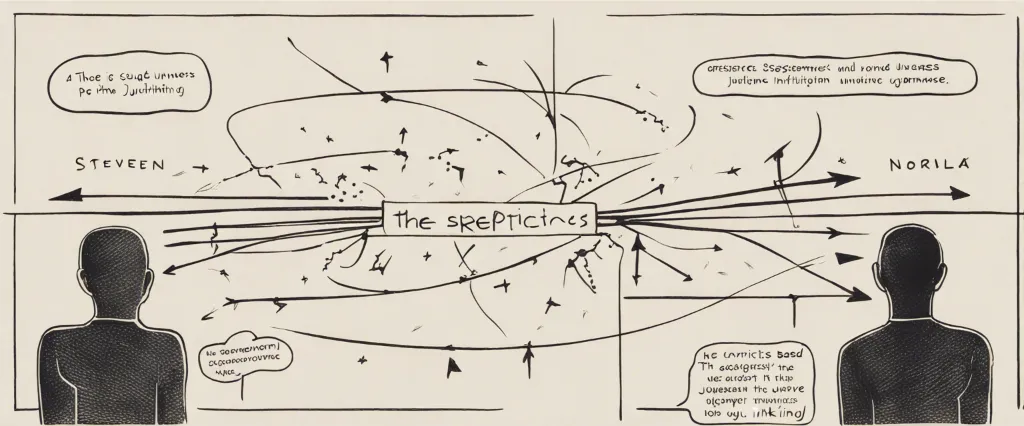In “The Skeptics’ Guide to the Universe,” Steven Novella presents an insightful and thought-provoking exploration of scientific skepticism, critically examining popular beliefs and pseudoscience that permeate our society. Novella, a prominent neurologist and outspoken skeptic, possesses a wealth of expertise in the scientific method, logic, and critical thinking. Through his vast experience and engaging writing style, Novella serves as the perfect guide for readers eager to unravel and differentiate between genuine scientific claims and unfounded assertions.
Chapter 1: Introduction to Critical Thinking: Navigating the Maze of Misinformation
Chapter 1 of The Skeptics’ Guide to the Universe by Steven Novella, titled “Introduction to Critical Thinking: Navigating the Maze of Misinformation,” serves as a foundational overview for the rest of the book. Novella emphasizes the importance of critical thinking in an era filled with misinformation and pseudoscience.
The chapter begins by addressing the prevalence and impact of misinformation in today’s society, highlighting the dangers of blindly accepting baseless claims and the subsequent erosion of rational thinking. Novella states that cognitive biases and logical fallacies can cloud our judgment, making it crucial to learn critical thinking skills to navigate this complex landscape.
He proceeds to dissect common fallacies and misconceptions that hinder critical thinking, such as the argument from ignorance, anecdotal evidence, and the post hoc fallacy. Novella underscores the need to recognize and challenge these flawed patterns of thinking in order to make informed decisions.
Furthermore, the chapter provides an introduction to scientific skepticism, as Novella believes it is an essential tool for critical thinking. He explains that skepticism doesn’t mean denying everything but rather adopting a provisional acceptance of claims based on scientific evidence and rigorous investigation.
Novella emphasizes the scientific method as the most reliable means to discern reality, emphasizing the concepts of skepticism, doubt, and intellectual humility. By encouraging readers to actively engage in critical thinking, he aims to develop a community of skeptics who can address misinformation and foster a more rational approach to understanding the world.
In conclusion, Chapter 1 of The Skeptics’ Guide to the Universe lays the foundation for exploring critical thinking, skepticism, and the dangers of misinformation. Novella aims to equip readers with the tools necessary to navigate the complexities of our information-rich society and make well-informed decisions rooted in scientific evidence.
Chapter 2: Debunking Pseudoscience: Separating Fact from Fiction
Chapter 2 of “The Skeptics’ Guide to the Universe” by Steven Novella focuses on debunking pseudoscience and highlighting the importance of separating fact from fiction. Novella begins by emphasizing the need for critical thinking and a skeptical mindset when evaluating claims made by pseudoscientific practices.
He discusses the concept of scientific skepticism, which involves assessing claims based on evidence and rational analysis rather than personal beliefs or biases. Novella points out that many pseudoscientific ideas are inherently unfalsifiable, making it difficult to prove them wrong. However, this does not make them valid or scientific.
The chapter delves into various pseudoscientific examples, such as homeopathy, astrology, and psychics. Novella explains how these practices often rely on anecdotal evidence, flawed reasoning, and cherry-picking data to support their claims. He discusses the significance of the placebo effect, emphasizing that just because individuals experience perceived benefits does not mean the treatment is effective.
Furthermore, Novella highlights the importance of understanding the scientific method, emphasizing the need for empirical evidence, peer review, and replication. He discusses the dangers of relying on personal testimonials or expert opinions without considering the broader scientific consensus.
Throughout the chapter, Novella emphasizes the role of critical thinking, skepticism, and scientific literacy in differentiating between genuine scientific claims and pseudoscience. He stresses the need for individuals to question and critically evaluate information, especially in an era where misinformation can easily spread.
In summary, Chapter 2 of “The Skeptics’ Guide to the Universe” provides a comprehensive overview of debunking pseudoscience. It stresses the importance of applying critical thinking and evaluating claims based on empirical evidence, highlighting the flaws and limitations of pseudoscientific practices.
Chapter 3: The Scientific Method: Unraveling the Mysteries of Inquiry
Chapter 3 of “The Skeptics’ Guide to the Universe” by Steven Novella is titled “The Scientific Method: Unraveling the Mysteries of Inquiry.” This chapter serves as a comprehensive introduction to the scientific method, its key components, and its importance in uncovering the mysteries of the world.
Novella begins by highlighting the foundation of science: skepticism. He emphasizes the need for critical thinking and questioning in order to avoid biased thinking and confirmation biases. Skepticism sets the stage for the scientific method, which is a systematic approach to acquiring knowledge and understanding.
The chapter then delves into the core components of the scientific method: observation, hypothesis formation, experimentation, and analysis. Novella discusses the importance of carefully observing the world around us and recognizing patterns or anomalies. These observations can lead to the development of hypotheses, which are tentative explanations that can be tested.
Experimentation is a critical aspect of the scientific method. Novella explains the significance of controlled experiments and the role of variables in determining causation. He also emphasizes the importance of replication, peer review, and statistical analysis to ensure the validity and reliability of scientific findings.
Novella goes on to explore the concept of scientific theories, which are well-supported explanations for a wide range of phenomena. He emphasizes that scientific theories are not mere guesses but are robust explanations supported by a vast body of evidence.
In conclusion, Chapter 3 of “The Skeptics’ Guide to the Universe” provides a comprehensive overview of the scientific method. Novella highlights the significance of skepticism, observation, hypothesis formation, experimentation, analysis, and peer review in the pursuit of scientific knowledge. By adhering to these principles, scientists can unravel the mysteries of the world and discover objective truths.
Chapter 4: Skepticism in Practice: Questioning Claims and Evaluating Evidence

Chapter 4 of “The Skeptics’ Guide to the Universe” by Steven Novella explores the practical application of skepticism in everyday life. It emphasizes the importance of questioning claims and evaluating evidence before accepting them as true.
The chapter begins by discussing the phenomenon of misinformation and how people are often swayed by false or misleading information. Novella emphasizes the need to develop critical thinking skills to navigate the vast amount of information available today. He introduces the process of evaluation, which involves asking questions, seeking evidence, and looking for logical consistency.
The author then delves into various techniques used to manipulate and deceive people. Novella highlights common fallacies and biases that can cloud judgment and hinder critical thinking. He emphasizes the importance of being aware of these tactics and recognizing when they are being employed.
Novella also discusses the role of subjective experiences in evaluating claims. He points out that personal anecdotes may not always be reliable, as they can be influenced by bias and perception. To overcome this limitation, he suggests looking for objective evidence that can be independently validated.
The chapter concludes by exploring the concept of scientific skepticism. Novella explains that skeptics do not reject claims outright but approach them with a healthy skepticism, demanding evidence to support them. He emphasizes the need for skepticism to be balanced, open-minded, and based on scientific principles.
Overall, chapter 4 highlights the practical application of skepticism, encouraging readers to question claims, evaluate evidence critically, and adopt a scientific mindset when assessing the validity of information.
Chapter 5: Cognitive Biases and Logical Fallacies: Avoiding Common Thinking Traps
Chapter 5 of The Skeptics’ Guide to the Universe by Steven Novella delves into the concept of cognitive biases and logical fallacies, highlighting the importance of being aware of these thinking traps in order to think critically and make rational decisions.
The chapter begins by explaining cognitive biases, which are systematic errors in thinking that often lead to inaccurate conclusions. Novella lists out and examines various common cognitive biases such as confirmation bias, where individuals tend to seek out information that confirms their pre-existing beliefs, and availability heuristic, which leads to overestimating the probability of events based on how easily examples come to mind.
Next, Novella explores logical fallacies, which are errors in reasoning that can weaken arguments. These fallacies can be intentional or unintentional and can occur in various forms such as ad hominem attacks, where arguments are dismissed based on attacking the person making them rather than the content of the argument itself, or appeals to authority, where an argument is presented as valid solely because it is endorsed by an authority figure.
The chapter emphasizes the importance of recognizing these biases and fallacies to develop critical thinking skills. Novella provides tips on how to avoid falling into these thinking traps, such as seeking out opposing viewpoints and refining research methods.
In conclusion, Chapter 5 of The Skeptics’ Guide to the Universe highlights the impact of cognitive biases and logical fallacies on our thinking processes. By being aware of these common thinking traps, we can improve our ability to think critically and make well-informed decisions.
Chapter 6: Science Communication: Bridging the Gap between Experts and the Public
Chapter 6 of “The Skeptics’ Guide to the Universe” by Steven Novella is titled “Science Communication: Bridging the Gap between Experts and the Public.” In this chapter, Novella explores the challenges and importance of effectively communicating scientific information to the general public.
Novella starts by discussing the issue of scientific illiteracy and the various factors that contribute to it. He highlights the impact of misinformation, cognitive biases, and sensationalized media reporting on public understanding of science and the spread of pseudoscience. Novella emphasizes the need for scientists and experts to address this knowledge gap and convey accurate information in a way that engages and educates the public.
The chapter then delves into the strategies and techniques that can be employed to improve science communication. Novella advocates for using clear and plain language, avoiding technical jargon, and utilizing relatable examples to make complex concepts understandable. He also stresses the significance of storytelling, visual aids, and humor in capturing and maintaining public interest.
Furthermore, Novella emphasizes the importance of building trust with the audience by acknowledging uncertainties, addressing controversies, and admitting when there is insufficient evidence. He encourages scientists and experts to maintain an open dialogue and engage in active listening to better understand public concerns and address them effectively.
In the final sections of the chapter, Novella discusses the role of science communicators in countering misinformation and promoting critical thinking. He highlights the need to debunk pseudoscience and myths while being respectful and acknowledging common misconceptions. Novella also emphasizes the significance of fostering a scientific mindset and teaching the public about the scientific method and the importance of evidence-based decision making.
Overall, Chapter 6 emphasizes the critical role of science communication in bridging the gap between experts and the public. By employing effective communication strategies and fostering open dialogue, scientists and experts can help improve scientific literacy, combat misinformation, and promote a better understanding of science among the general public.
Chapter 7: The Skeptic’s Toolkit: Tools for Analyzing and Debunking Claims
Chapter 7 of “The Skeptics’ Guide to the Universe” by Steven Novella, titled “The Skeptic’s Toolkit: Tools for Analyzing and Debunking Claims,” provides readers with essential tools and strategies to critically evaluate and debunk various claims. Novella emphasizes the importance of skepticism and reasoning when faced with extraordinary or questionable assertions.
The chapter begins by highlighting the significance of Occam’s Razor, which states that the simplest explanation is often the most likely one. Novella encourages skeptics to avoid unnecessary complexity and look for straightforward explanations before considering more elaborate or supernatural possibilities. He also stresses the importance of considering prior probability and relying on reliable evidence in evaluating claims.
Next, Novella discusses logical fallacies that often hinder critical thinking, such as ad hominem attacks, strawman arguments, and appeals to authority. He urges skeptics to identify these fallacies when analyzing claims, as they can mislead and distract from the underlying evidence.
The concept of burden of proof is another essential tool discussed in this chapter. Novella explains that the burden of proof lies with those making extraordinary claims, and skeptics are not required to prove a negative. He advises skeptics to ask for evidence and be skeptical of unsupported assertions.
Furthermore, the chapter explores strategies for assessing scientific studies and identifying bias. Novella discusses the peer-review process, conflicts of interest, and the importance of replication. He emphasizes the significance of well-conducted experiments and properly controlled studies to minimize bias and ensure accurate results.
Lastly, Novella provides guidance on how to identify reliable sources of information, emphasizing the need to seek sources grounded in scientific consensus and peer-reviewed research. He warns against relying solely on anecdotes or personal experiences.
In summary, Chapter 7 of “The Skeptics’ Guide to the Universe” equips readers with valuable tools and approaches for evaluating and debunking claims. Novella encourages skepticism, critical thinking, and reliance on evidence-based reasoning when confronted with extraordinary assertions. By employing Occam’s Razor, avoiding fallacies, understanding the burden of proof, evaluating scientific studies, and seeking reliable sources, skeptics can effectively analyze and challenge dubious claims.

Chapter 8: Skepticism and Society: Promoting Critical Thinking in a World of Beliefs
Chapter 8 of “The Skeptics’ Guide to the Universe” by Steven Novella focuses on the role of skepticism in society and the importance of promoting critical thinking in a world filled with various beliefs. The chapter explores how skeptical thinking can help individuals navigate through the overwhelming amount of misinformation and pseudoscience that they encounter on a daily basis.
Novella emphasizes the significance of skepticism in combating the spread of misinformation and the acceptance of unfounded beliefs. He discusses the effect of cognitive biases and social pressures on people’s judgment and decision-making, highlighting the need for critical thinking skills to counteract these influences. Skepticism, he argues, is not about being a cynic or a contrarian, but rather about applying a rational and evidence-based approach to evaluating claims.
The chapter also delves into the various strategies and tools that skeptics can employ to promote critical thinking. Novella discusses the importance of science communication and the role of skepticism in the media. He encourages skeptics to actively engage in public debates and discussions, challenging pseudoscientific claims and promoting scientific literacy.
Furthermore, Novella explores the ethical considerations of skepticism, touching upon issues such as the balance between respecting individual autonomy and combating harmful beliefs. He emphasizes the importance of approaching skeptical discussions with empathy and understanding, recognizing that people’s beliefs are often deeply ingrained and emotionally charged.
In summary, Chapter 8 of “The Skeptics’ Guide to the Universe” addresses the role of skepticism in society, emphasizing the significance of promoting critical thinking to navigate the vast array of beliefs and misinformation. Novella highlights the importance of science communication, public engagement, and ethical considerations in the skeptical movement.
After Reading
In “The Skeptics’ Guide to the Universe,” author Steven Novella presents an illuminating exploration into the world of skepticism and critical thinking. Throughout the book, Novella delves into various topics such as pseudoscience, logical fallacies, and the importance of evidence-based reasoning. With a captivating writing style, Novella enlightens readers about the strategies used by charlatans and quacks, while also providing tools to discern truth from fiction. By emphasizing the significance of skepticism in a world inundated with misinformation, Novella empowers readers to cultivate their critical thinking skills and navigate the complexities of today’s information landscape. Ultimately, “The Skeptics’ Guide to the Universe” serves as an indispensable guide for those who seek to understand and engage with the world through a skeptical lens.
1. The Demon-Haunted World: Science as a Candle in the Dark” by Carl Sagan
– Similar to “The Skeptics’ Guide to the Universe,” this book explores critical thinking and the importance of science as a tool in navigating the challenges of a complex world. It delves into the dangers of pseudo-science, superstition, and misinformation, ultimately promoting scientific skepticism.
2. “Bad Science” by Ben Goldacre
– In this book, Ben Goldacre examines the numerous ways in which science and evidence are misused, manipulated, and distorted in various fields such as medicine, nutrition, and psychology. “Bad Science” provides readers with the necessary tools to distinguish genuine scientific research from flawed or fraudulent claims.
3. Thinking, Fast and Slow” by Daniel Kahneman
– This book, written by Nobel laureate Daniel Kahneman, explores the two systems of thinking that influence our judgments and decision-making processes. By uncovering the biases and limitations of our thought processes, readers are encouraged to develop a more rational and skeptical approach to interpreting information and making choices.
4. “The Believing Brain: From Ghosts and Gods to Politics and Conspiracies—How We Construct Beliefs and Reinforce Them as Truths” by Michael Shermer
– In “The Believing Brain,” Michael Shermer examines the evolutionary roots behind our tendencies to form and reinforce beliefs, even in cases where there is little evidence or rational basis. Through various examples, Shermer explores the cognitive and social mechanisms that often drive belief systems, challenging readers to critically evaluate their own beliefs.
5. “The Science of Good and Evil: Why People Cheat, Gossip, Care, Share, and Follow the Golden Rule” by Michael Shermer
– This book tackles the fundamental question of morality from a scientific perspective. Michael Shermer explores the origins of moral beliefs and behaviors, drawing upon evolutionary biology, psychology, and sociology. By examining the scientific basis for our moral instincts and actions, Shermer invites readers to approach ethical questions with a skeptical and evidence-based mindset.




